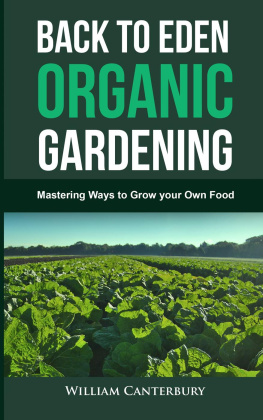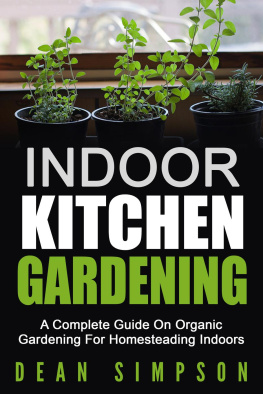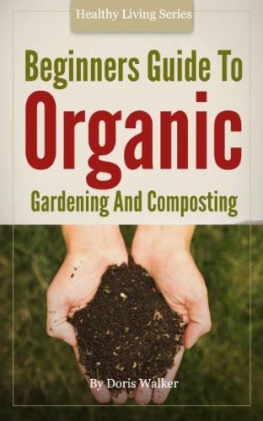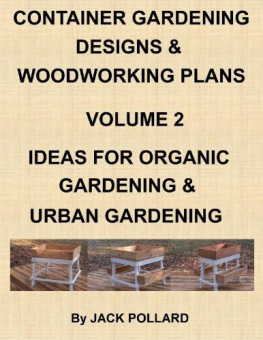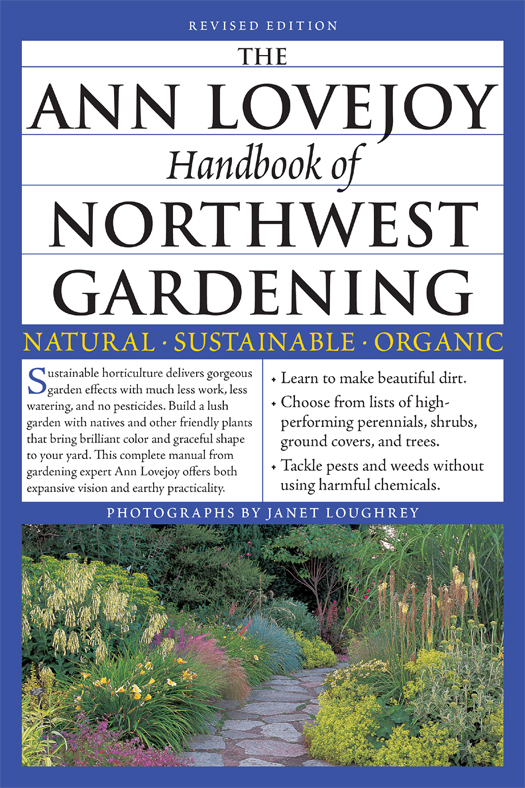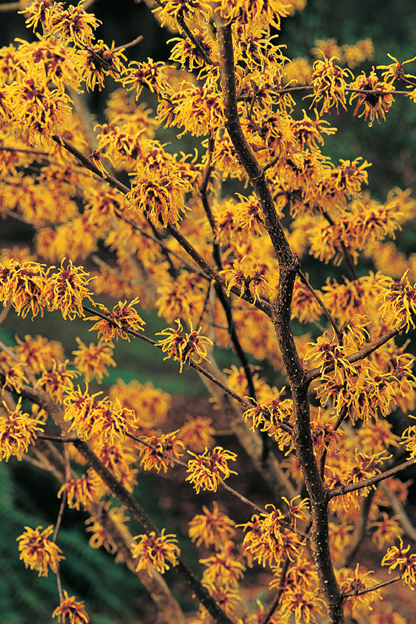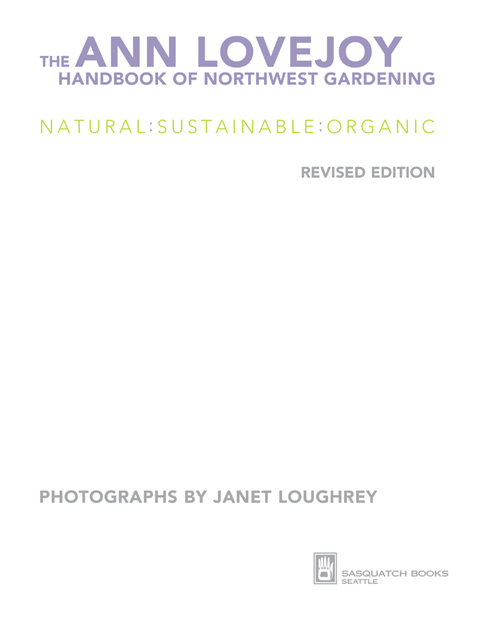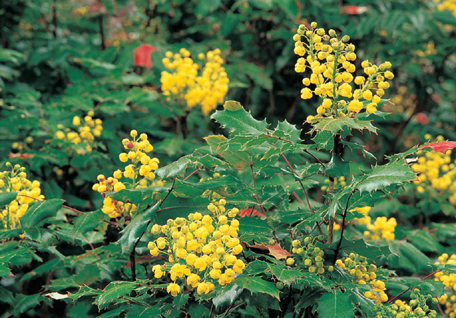Copyright 2003, 2007 by Ann Lovejoy
All rights reserved. No portion of this book may be reproduced or utilized in any form, or by any electronic, mechanical, or other means without the prior written permission of the publisher.
Published by Sasquatch Books
Distributed by PGW/Perseus
Cover design: McGuire Barber Design
Interior design: Rowan Moore/doublemranch.com
Cover & interior photographs: Janet Loughrey
Interior illustrations: Bill Evans
Copy editor: Rebecca Pepper
Library of Congress Cataloging in Publication Data is available.
eISBN: 978-1-57061-878-9
Sasquatch Books
119 South Main Street, Suite 400
Seattle, WA 98104
206/467-4300
www.sasquatchbooks.com
v3.1
CONTENTS :
To all compost lovers, everywhere.
INTRODUCTION
For many years, gardening was Americas favorite leisure activity. Many of us found it relaxing to do a little weeding and watering in the cool of the evening after work. Early risers might put in an hour or two of garden puttering before the family was ready for breakfast. We happily spent our weekends on lawn care and in grooming beds and borders. Today gardening still ranks high on many Americans to-do lists, but something has changed.
Despite the modern conveniences at our disposal, our lives are busier than ever. We spend our days rushing from meeting to workshop, or from soccer practice to the dentist. The busier we get, the more we need relaxation. Gardening can be relaxing, but it can also be a competitive sport, pursued with the same intensity we bring to our work. Years ago most folks were content to have a nice lawn surrounded by pretty shrubs, a tree or two, and some colorful flowers. Today we want beauty, elegance, and style, right now. Unfortunately, most of us take our cues from high-maintenance models that eat time.
Busy people dont need needy gardens. Busy people need green havens, lovely places where they can be gracefully enveloped in the natural without stressing about weeds. By gardening naturally, following the principles of sustainable design, we can have year-round gardens that provide beauty, style, and elegance with a modicum of work. What does it mean to garden naturally? Natural care is a way of gardening in cooperation with natural patterns, from weather and soil type to the size and shape of plants.
In contrast, many standard gardening practices are aimed at controlling nature; these do not work well or for long. Those who have made gardens with high hopes only to find themselves slaves to an endless stream of chores already know this: Nearly all traditional gardens require more work from the gardener with each passing year, and they often deliver less and less satisfaction. In addition, gardens made using classic techniques are decidedly not sustainable. Leave most gardens alone for a few weeks in July and you will come home either to a rampant jungle (if somebody watered for you) or a bone-dry desert.
Whats the alternative? Happily, its not artificial turf and plastic flowers, but a handsome, thriving landscape full of regionally appropriate plants that appreciate the natural conditions we can offer them. Sustainable design allows us to create flexible, adaptable gardens that grow less needy each year. Most of the work comes up front, when we make beautiful soil and simplify the shapes and flow patterns within the garden. Applying the concepts of sustainable design helps us to reduce or eliminate many repetitive chores likes weeding, fertilizing, and watering. Once the garden is established, annual chores consist largely of mulching and grooming. Seasonal chores still include some fertilizing, dividing, watering, and weeding, but a well-designed, well-planted garden of up to an acre can be kept in tip-top condition with an average of only two chore hours a week.
Successful gardening depends on many factors, only a few of which we can change. The Pacific Northwest can be one of the worlds best places to garden. However, our region also has challenging native soils that can be difficult to improve, interesting weather, and little summer rain. Fortunately, thousands of attractive and useful plants will grow well here, given the proper start and follow-up care. But to take full advantage of our regional riches, we need to rethink a great deal of standard garden advice, in terms of care and culture and design.
A very high percentage of North American garden books are written primarily for the Eastern seaboard. Although the Northwest is sometimes called little England by the envious, the advice offered in imported English books does not always apply directly on this side of the water. Even books that are supposed to be specifically for the Northwest may have a California bias. (The largest market share generally gets the greatest attention.) The goal of this particular handbook is to make it very easy to be a happy and satisfied gardener in the maritime regions of the Pacific Northwest, which we refer to as Cascadia.
In geologists terms, Cascadia is the stretch of land west of the Cascade Mountains, starting in southern British Columbia and reaching into Northern California. This same region is also the natural range of the salmonberry and the glittering rufous hummingbird that feeds on salmonberry nectar. The famous Northwest native flora has won awards from horticulture societies all over the world. These plants, our several types of native soils, and all the various attributes of our modified Mediterranean climate are what make gardening here differentsometimes just a little, sometimes a lot. Our gardens are most lastingly successful when we take these differences into account.
Our Northwestern native flora is well-adapted to our typical dry summers and wet winters. Thus, durable native beauties like fragrant, evergreen Mahonia aquifolium earn their way into gardens of all sizes.
If we try to garden as people do back East or even in England, sooner or later well run into problems. When we take our cues from the plants around us, we can adapt our gardens to take advantage of the natural strengths of our region. Naturally, we cant grow everything in the world, but we can grow a huge range of plants very well indeed. Our own rich and varied native flora is an obvious place to start looking for plants adapted to our regional weather cycle of wet winters and dry summers. (This cyclical pattern is what classifies our climate as a modified Mediterranean type.) Certainly, we do not need to limit our garden plantings to natives, but our exceptional flora does make an excellent basis for a relatively independent matrix of garden plants.
I often use a palette of what I call natives and allies, combining Northwest natives and their relatives from similar parts of the world, along with natural allies or companion plants and their relatives. This simple formula provides a large, varied, and adaptable selection of plants that settle in quickly and need relatively little care once established. When we stick to the thousands of plants, natives and not, that love the conditions we can offer them, we reduce pest and disease problems dramatically. Thats because plants that are happy to be here are generally healthy. With nature on their side, gardeners in the maritime Northwest can make gardens that are as good as any in the world.


